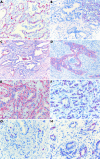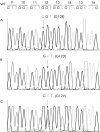Molecular characterisation of pancreatic ductal adenocarcinoma in patients under 40
- PMID: 16497872
- PMCID: PMC1860388
- DOI: 10.1136/jcp.2005.027292
Molecular characterisation of pancreatic ductal adenocarcinoma in patients under 40
Abstract
Background: Pancreatic ductal adenocarcinoma (PDAC) rarely affects people under 40.
Objectives: To determine whether the clinical, pathomorphological and genetic features of PDAC occurring in young patients (<or=40 years) differ from those in elderly patients.
Methods: Clinical and pathomorphological data were obtained from seven patients presenting with PDAC, with age ranging from 35 to 40 years of age (mean 38 years). All tumours were characterised by using immunohistochemistry and molecular genetics.
Results: All seven patients were women and lacked an association to cancer-predisposing genetic syndromes. Four patients were smokers and one had non-hereditary chronic pancreatitis. Pathomorphologically, tumours in three patients displayed moderate differentiation and four showed poor differentiation including one adenosquamous carcinoma. All tumours showed overexpression of transforming growth factor beta1 and loss or significant reduction of Smad4. Accumulation of p53 and overexpression of epidermal growth factor receptor (EGFR) were seen in five and four patients, respectively. No expression of p16, oestrogen hormone receptor or progesterone receptor was found. Mismatch repair gene products (MutL homologue 1 (MLH1), MSH2 and MSH6) were expressed in all tumours. Mutational analyses showed K-ras mutations in only three of the seven tumours.
Conclusion: A large clinical, pathomorphological and genetic overlap of PDAC in young patients aged under 40 is seen with that in elderly patients. The existence of yet undefined initiating events of pancreatic carcinogenesis is suggested by the low rate of K-ras mutations, in at least a subgroup of young patients.
Conflict of interest statement
Competing interests: None declared.
References
-
- Solcia E, Capella C, Klöppel G. Tumors of the pancreas. In: Rosai J, Sobin LH, eds. Atlas of tumor pathology, 3rd Series, Fascicle 20. Washington, DC: Armed Forces Institute of Pathology, 1997
-
- Ghadirian P, Lynch H T, Krewski D. Epidemiology of pancreatic cancer: an overview. Cancer Detect Prev 20032787–93. - PubMed
-
- Klöppel G, Hruban R H, Longnecker D S.et al Ductal adenocarcinoma of the pancreas. In: Hamilton SR, Aaltonen LA, eds. World Health Organization classification of tumours. Pathology and genetics of tumours of the digestive system. Lyon: IARC Press, 2000
MeSH terms
Substances
LinkOut - more resources
Full Text Sources
Medical
Research Materials
Miscellaneous


